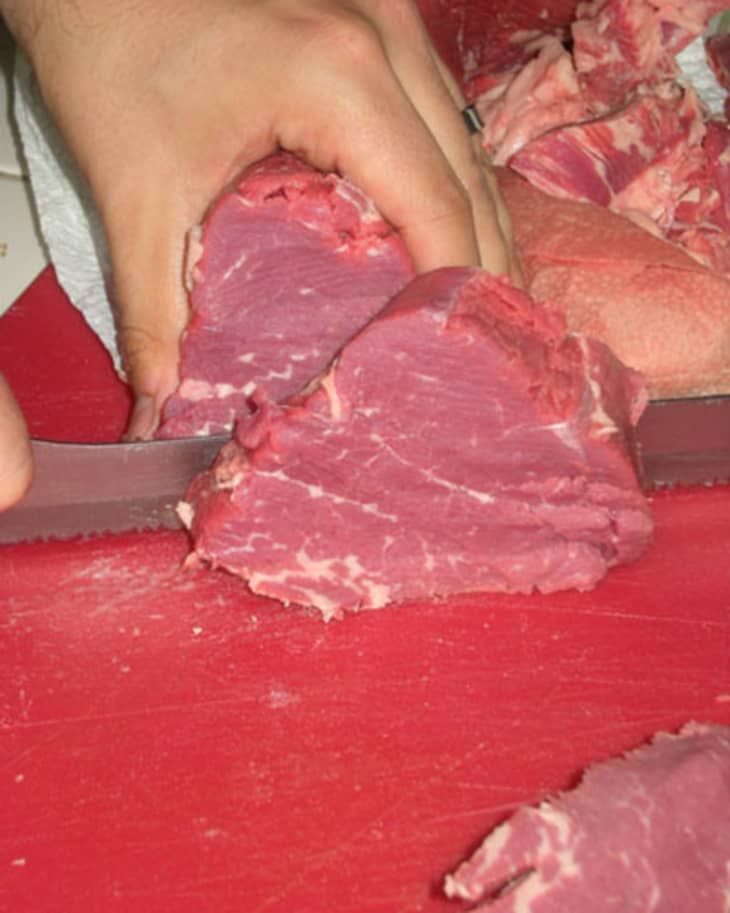How To Butcher a PSMO (Peeled, Silver Skin, Side Muscle On) Beef Tenderloin Guest Post from Michael and Elizabeth of Take Back Your Kitchen
When regarding the legitimacy of Food content on TV one question is paramount: where is the line between entertainment and enlightenment? Naturally, any delineation is completely subjective, as much for the program as for its particular viewer. Yet everyone seems to have an opinion as to which TV chefs are worth their salt and which should be chopped up as a garnish.
Each individual consumer must make up his or her own mind as to the essence of a program and how much they want to extract.
That being said, my mind automatically moves to my favorite TV foodite, Alton Brown. His simple, scientific approach to cooking resonates well with me, as I am little more than a simple scientist myself. However, I know that many find his attitude towards food stilted or even off-putting, overly academic, convoluted or persnickety. His cocky style and sometimes daunting instructions force his viewers to look inward and ask, is any of this worth it? Is frying a turkey worth constructing a 12-foot derrick in my backyard? Do I really need to try my hand at avocado ice cream?
When a scientist publishes groundbreaking work, it is met with skepticism because scientists are taught to be skeptics (even when assessing ourselves). We set out to duplicate amazing results, both to validate the initial work and to benefit from the discovery ourselves. Therefore, I resolved to act out one of Alton Brown’s episode-long demonstrations, the butchering of a whole beef tenderloin and preparation of its constituents. I did this as much as a scientist as a lover of food, or put another way, as much for the experience as to reap (eat) the rewards.
This PSMO was $47 at the price club, but they had ones for as low as $40; however, this one was also a little fatty. When purchasing, remember to flip the thing over and check the bottom. It should be relatively smooth and not very fatty, unless you want fattier meat, of course. Still, some can be a bit chewed up on the bottom, so be aware of this.
Now, my butchering skills notwithstanding, let’s get to work!
1. Remove the beast from the wrapper, pat dry with paper towels or rinse off in a sink.
2. Feel for the easily separable membrane that holds the chain in place. The chain is the side meat, which is generally fattier and tough than the rest of the cut. Use fingers to pull the chain away from the main body, notice the clear membrane giving way. Apply filleting blade when necessary. Set aside/freeze for later.
3. Remove excess fat and more importantly, the ‘silver skin’ with a sharp, flexible knife. The aim is not to cut into the top of the meat at all, although I definitely hit it a few times here and there. No big loss. Keep fingers on the silver skin and use the weight of the remaining meat to pull it away while you slice through.
4. At the end of the piece is a large section jutting off slightly from the main keel. Remove this with a single stroke. This becomes the chateaubriand roast. Wrap, keep cool and save!
5. All that should remain is a single, ovular section of meat. Slice 1.5″ rounds off of this. These are the filets. Set aside on a plate until the entire section is finished. I estimate each round can go from 4-8 oz, depending on the thickness of the PSMO you started with.
Finally, trim the steaks as needed and grill! On a hot grill, 5 minutes per side gave me medium doneness, I’d estimate 4 minutes for medium rare, but I like to grill one to start off to get a feel for the grill, the heat, etc. just to be safe. Also remember that the little ones will finish first. Because you’re dealing with an entire section of cow, it’s difficult to keep the steaks uniform, but do the best you can. Remember- have fun! Buono Apetito!
Thank you for sharing, Michael and Elizabeth!
Take Back Your Kitchen
Tell us all about it here.
(Images: Elizabeth of Take Back Your Kitchen)
